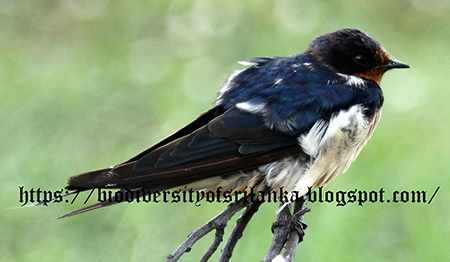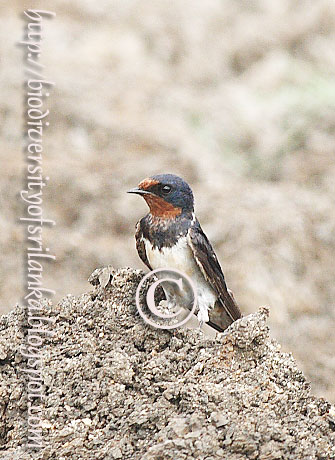English Post >>
Pages
- Home
- Flora of Sri Lanka
- Dragonflies & Damselflies of Sri Lanka
- Butterflies of Sri Lanka
- Freshwater Fishes of of Sri Lanka
- Amphibians of Sri Lanka
- Snakes of Sri Lanka
- Tetrapod Reptiles of Sri Lanka
- Mammals of Sri Lanka
- Resident Birds of Sri Lanka
- Migrant Birds of Sri Lanka
- Vagrant Birds of Sri Lanka
- Status Uncertain or Doubtful Birds of Sri Lanka
Showing posts with label Hirundinidae. Show all posts
Showing posts with label Hirundinidae. Show all posts
Friday, August 25, 2023
කඳු වැහිළිහිණියා/හෙල් වැහිළිහිණියා (Hirundo domicola)
කඳුකරයේ තෘණ භූමි සහ වගා බිම් වල මෙන්ම ගම් සහ නගර වල විවෘත ස්ථාන වලද සුලභ දේශීය පක්ෂියෙකි. තෙත් කලාපයේදී කඳුකරයේ පාමුල ප්රදේශ වලද ඇතැම්විට දැකිය හැක. කුඩා පියාඹන කෘමීන් ප්රධාන වශයෙන් ආහාරයට ගන්නා කඳු වැහිළිහිණියා ඔවුන්ගේම කුඩා රංචු ලෙසින් හෝ වෙනත් වැහිළිහිණි විශේෂ සමග පියාඹමින් එම සතුන් ගොදුරු කරගනී. පෙබරවාරි සිට මැයි දක්වා කාලයේ සහ නැවතත් සැප්තැම්බර් මාසයේ බිත්තියක හෝ පාරක ඉවුරේ හෝ වෙනත් එවැනි ස්ථානයක මඩ සහ පිදුරු එකතු කර වටේට පිහාටු යොදා තනන කෝප්පයක හැඩැති කූඩුවක බිත්තර 2 ක් හෝ 3 ක් දමා අභිජනනයේ යෙදේ.
Saturday, April 16, 2022
ශ්රී ලංකා වැහිළිහිණියා/බඩ රතු වැහිළිහිණියා (Hirundo hyperythra)
මෙරටට ආවේනික සුලභ පක්ෂියෙකි. දිවයින පුරාම පාහේ වනාන්තර වල විවෘත ස්ථාන, වගා බිම්, කුඹුරු සහ ලඳු කැලෑ වල දැකිය හැක. බොහෝවිට ජෝඩු වශයෙන් හමුවන අතර ඇතැම් විට කුඩා රංචු ලෙසින්ද හැසිරේ. බොහෝවිට පොළොවට ආසන්නව පියාඹමින් ඉගිලෙන කෘමින් ගුවනේදී ගොදුරු කර ගනී. ගල් ගුහාවක වහලයේ, පාලමක් යට හෝ ඇතැම් විට ගොඩනැගිල්ලක හෝ නිවසක වහලයේ යට මඩ වලින් බෝතලයක හැඩය සහිත කූඩුවක් සාදා අප්රියල් සිට ජූලි දක්වා කාලයේ බිත්තර දෙකක් හෝ තුනක් දමා අභිජනනය කරයි.
English Post >>
Tuesday, March 1, 2022
ඉවුරු වැහිළිහිණියා/කරපටි ඉවුරුළිහිණියා (Riparia riparia)
දුර්ලභ නමුත් නිත්ය සංක්රමණික පක්ෂියෙකි. වියලි කලාපයේ බොහෝවිට ජල මූලාශ්රයකට ආසන්න විවෘත බිම් වල හමුවේ. ප්රධාන වශයෙන් දකුණු වෙරලබඩ කලාපයේ වාර්තා වේ. නිතරම අටු වැහි ලිහිණි රංචු සමග විදුලි කම්බි හෝ දුරකතන කම්බි මත වසා සිටින ආකාරය නිරීක්ෂණ කල හැක. ඉවුරු වැහිලිහිණියා උතුරු ඉන්දියාවේ සහ උතුරු ඇමෙරිකාවේ අභිජනනය කරයි.
English Post >>
Saturday, April 11, 2020
අටු වැහිලිහිණියා (Hirunda rustica)
ඊසාන දිග මෝසම් සුලං ආරම්භයත් සමග මෙරටට පැමිණ අප්රේල් අවසානය දක්වා පමණ දිවයින පුරාම පාහේ දැකිය හැකි ඉතාමත් සුලභ සංචාරක පක්ෂියෙකි. ඉතා වේගයෙන් පියාඹමින් අහසේදී කෘමීන් ගොදුරු කර ගන්නා අටු වැහිලිහිණියා දවසේ වැඩි කාලයක් පියාඹමින් ගත කරයි. නිතරම 10 සිට 30 දක්වා පමණ හෝ ඊටත් වඩා වැඩි රංචු ලෙසින් හමුවන අටු වැහිලිහිණියන් සමූහ වශයෙන් ටෙලිපෝන් හෝ විදුලි රැහැන් මත වසා සිටිනු දැකිය හැක. මෙරට තුල රැදී සිටින සමයේ රාත්රියේදී දහස් ගනන් රංචු ලෙස රත්නපුර වැනි නගර වල විදුලි රැහැන් මත වසා සිටින අටු වැහිලිහිණියන් සුලභ දසුනකි.
English Post >>
English Post >>
Sunday, December 17, 2017
Bank Swallow/ඉවුරු වැහිළිහිණියා/කරපටි ඉවුරුළිහිණියා[Iwuru Waehilihiniya/Karapati Iwurulihiniya] (Riparia riparia)
සිංහලෙන් කියවන්න >>
Sunday, October 12, 2014
Vagrant Swallows and Martins (Family: Hirundinidae) recorded in Sri Lanka
Birds that appear outside their normal range are known as vagrants. This post summarizes up to date published sight records of vagrants of the family Hirundinidae( Swallows and Martins) in Sri Lanka.
Confirmed vagrants
1) Wire-tailed Swallow (Hirundo smithii filifera)
Confirmed vagrants
1) Wire-tailed Swallow (Hirundo smithii filifera)
As per Phillips first sight-record was on 26th February 1966 of a single bird observed by Mrs. R.Wynell-Mayow and Mrs. Nugawela on a telegraph wire on the roadside between Pooneryn and Mannar (Phillips W.W.A, 1978:63). However W.A. Cave stated in 1907 of a possible sight record of it in Colombo. Here are his words – “I should be glad if any ornithologist can tell me whether the Wire-tailed swallow [Hirundo smithii) has been observed in Ceylon. I am almost certain I saw one hawking over the sides of the Colombo Lake on July 1st of this year. The bird was very much like H. rustica, but the length of the outer tail feathers, white under parts and conspicuous white spots on the rectrices attracted my attention. If it was not H. smithii it must have been a common swallow in full summer plumage, and its presence here on the above-mentioned date is somewhat unusual, and I think worthy of record.”(Cave, W.A., 1907). Kotagama & Ratnavira (2010) has given another sight record in 1979 quoting CBC notes (CBCN 1979 Oct: 35)
Unconfirmed vagrants:
Species for which there are only one or two sight records exist are categorized here as unconfirmed vagrants. Problematic records without sufficient details are also included.
2) Pale Crag-martin (Hirundo obsoleta pallida)
Bligh has reported an occurrence of a Martin in Kandapolla valley in the Haputhale range during North-east monsoon of 1876 and again in cool season of 1877-78. Legge suggested the possibility of it being the Pale Crag-martin (Legge V. 1880: 774-775). Recent sight record of it on 5th March 1988 at Kotte was reported by Rex I. De Silva (Kotagama S. & Ratnavira G. 2010: 279 Quoting De Silva R.I., 1989) & (Kaluthota C.D. & Kotagama S.W., 2009)
3) Dusky Crag-martin (Hirundo concolor)
Single sight-record from the Bellanwila-Attidiya marsh on 21st January 1993 by Jagath Gunawardana is the only record so far available of its occurrence in Sri Lanka. (Hoffmann, T. W., 1994))
4) Streak-throated Swallow [Indian Cliff Swallow] (Hirundo fluvicola)
Single bird seen on a telegraph wire at Sita Eliya patanas close to Nuweraeliya on 8th February 1948 by W.W.A. Phillips is the first record of this swallow in Sri Lanka (Phillips W.W.A 1978:63 ). Second record is from Debarawewa, Tissa by Ben King and party on 6th February 1992. They observed two birds (Hoffmann, T. W., 1993). Probably the same species is again recorded as Indian Hill Swallow at Pannegamuwa in the 2008-2011 report of the Ceylon Bird Club, though it is mentioned in it as 2nd record after 25(?) years (Warakagoda D. & Sirivardana U., 2011).
References:
Cave, W.A. 1907- Rare Colombo birds. Spolia Zeylanica. 5(17):65
De Silva, R.I., 1989. New sight record: Pale crag-martin Malkoha Jan:2
Hoffmann, T. W., 1994. Ceylon Bird Club Notes, 1993. Loris, 20(3), 107-109.
Hoffmann, T. W., 1993. Notes from the Ceylon Bird Club, 1992. Loris, 20(1), p12-14.
Kaluthota C.D. & Kotagama S.W. 2009. Revised Avifaunal List of Sri Lanka, Occasional Paper No.02, October 2009, Field Ornithology Group of Sri Lanka (Downloaded from http://www.fogsl.net/Prod/wp-content/uploads/2009/11/Checklist-ver-7.pdf )
Kotagama, S., Ratnavira, G., 2010. An illustrated Guide to the Birds of Sri Lanka. Field Ornithology Group of Sri Lanka, Colombo.
Legge V., 1880. A History of the birds of Ceylon 1983 second edition.
Phillips W.W.A., 1978 Annotated checklist of the Birds of Ceylon (Sri Lanka) 1978 revised edition.
Warakagoda D. &
Sirivardana U., 2011. Report from the Ceylon Bird Club for 2008-2011, Loris 26
(1&2)
Saturday, April 21, 2012
Sri Lanka Swallow (Hirundo hyperythra)

Common resident bird recently split from
Red-rumped swallow (Hirundo daurica) adding another endemic bird to Sri lankan list. It is common all over the island in open areas of forests,
plantations, paddy fields and scrublands. Often encounters as pairs and
sometime as small flocks. It flies usually close to the ground and food
consists mainly of small insects captured on the wing. Sri Lanka Swallow built
bottle like nest with mud on roof of a cave, under a bridge or sometime even under a roof of a building or a house. Main breeding season is from April to July.
සිංහලෙන් කියවන්න >>
Friday, February 24, 2012
Hill Swallow/කඳු වැහිළිහිණියා/හෙල් වැහිළිහිණියා[Kandu Wehilihiniya/Hel Wehilihiniya] (Hirundo domicola)
Hill swallow is a common breeding resident found in grass lands, plantations and open areas in villages and towns of the hill
country while occasional visitor to the foot hills of the wet zone. Its food
consist of small flying insects capturing on the wing, usually as small flocks
of its own members or others of the family like red-rumped swallow, Barnswallow.etc.The breeding season is from February to May and again in September.
It lays 2 or 3 eggs in a mud and straw cup nest, lined with feathers and
bracketed on a wall, road-bank or earth-slip.
සිංහලෙන් කියවන්න >>
Sunday, November 14, 2010
Barn Swallow/Atu Wahilihiniya (Hirunda rustica)
Barn swallow is a very common winter visitor of all zones of the island, arriving at the beginning of the North-East monsoons and stay till end of April. It has a very fast flight and much of its time while in Sri Lanka
සිංහලෙන් කියවන්න >>
Subscribe to:
Comments (Atom)






